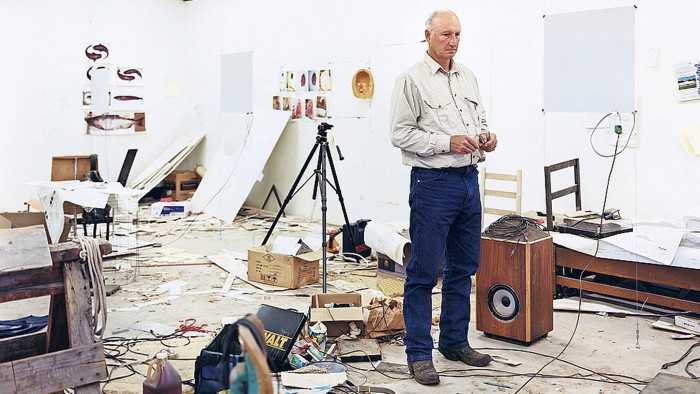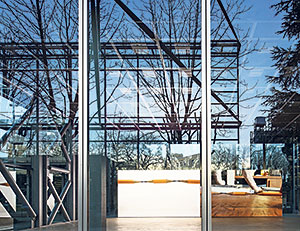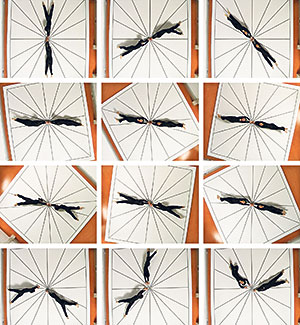Minimalism: Paris exhibition celebrates Bruce Nauman

Simply sign up to the Life & Arts myFT Digest -- delivered directly to your inbox.
Silently, three yellow pencils hover, touch, separate, on a sheet of blank white paper, magnified hundreds of times on one of a pair of huge LED screens. On the other, the same experiment plays out on a cluttered studio table amid just perceptible sounds of the tread of paws as a cat strolls by intermittently.
On a spring day in Paris, we watch this game of frustration and futility, tension and equilibrium, abstraction and glimmers of life, standing within an enormous crystalline box built on aluminium stilts. It is 8m high, 16m wide and the walls, made of glass, appear to dissolve into transparency and reflections. Around us are not only pencils and cats’ paws but the sun-dappled trees and buildings of Boulevard Raspail outside.
“Pencil Lift/Mr Rogers” (2013) is the opening piece in Bruce Nauman’s exhibition of old and new work at the Fondation Cartier, designed by Jean Nouvel in 1994. The American artist and the French architect are a marriage made in heaven. Born within a few years of each other in the 1940s, both have mathematics and philosophy in their background and came of age when, according to Nouvel, “the most important cultural movement was structuralism”.
Both have made prominent careers around an art of dematerialisation. Nouvel says his glassy façades “play on absence and presence, absence of limits”. Nauman fills the most daunting museum spaces with mere sounds or phrases, as he did in Raw Materials at Tate Modern’s Turbine Hall in 2004.
For those who, like me, tend to find much of Nauman either too horrible or too tedious to bear — the video Clown Torture screaming “no”; the banal repetitions across a 60-minute film of Tony Sinking into the Floor, Face Up, and Face Down — this exhibition is lifted to revelation by its setting. Flowing on to a wild garden centred on a cedar of Lebanon tree planted by the Romantic writer François-René de Chateaubriand in 1823, Nouvel’s building balances interior and outer space, enclosure and openness, in a perfect foil for the stress between claustrophobia and intellectual inquiry animating Nauman’s oeuvre.
Take the sound piece “For Children/Pour les Enfants” (2015). The words are proclaimed again and again by a male voice in a neutral tone, although sometimes with a grainy, imperfect sound quality that nags. Gradually, the insistent repetition becomes menacing, suggesting authority, extreme control, even abuse of power. Nauman’s peculiarly brilliant malevolence is to spark in every viewer his or her own nightmare associations: this piece, reworked into French for the Paris show, led me back to Louis Malle’s great film of the Occupation, Au Revoir Les Enfants (1987).

Meanwhile, the phrase “pour les enfants” echoes across an airy ground floor gallery, which reflects trees and clouds, conjuring freedom in contrast to the verbal rigidity of the piece. The sounds continue to resonate outside. Or have they by now merely lodged themselves in our heads? “Get Out of My Mind” is another Nauman title. Either way, the garden hosts a second sound piece, “For Beginners (Instructed Piano)”, which picks up the continuum of learning, discipline, manipulation, domination: the jarring, unmelodic score consists of instructions by Nauman regarding the random positioning of the pianist hands on the keyboard.
Repetition of daily tasks, life stripped bare, the macabre of the commonplace: Nauman’s bleak vision and austere deadpan manner are offset in these grand ground-level galleries by Nouvel’s high-spirited geometry. Downstairs, in a series of rooms from which all natural light has been blocked, things get more brutal. For “Untitled 1970/2009”, a double projection on a wall and on the floor, Nauman instructed two dancers stretched out on a mat to twirl until “they reach the point of exhaustion”. Their intertwined hands are the centre of the work, their bodies fan out into a circle as over and over they trace a mathematical formula into a spiral of endurance.

Life as a joyless dance to the music of time or as a sinister merry-go-round? After the dancers comes “Carousel” (1988), a fairground ride turned slaughterhouse: dismembered taxidermy models of deer, lynx and coyote, suspended from the neck, whirl around, scraping the floor as they go, filling the space with a hideous grating noise.
In competition is the incessant, abrasive singsong of a bald man with gaping mouth whose face in close-up is projected, sometimes upside down, on the surrounding walls and on half a dozen monitors. This is classical singer and performer Rinde Eckert chanting three phrases — “feed me/eat me/anthropology”, “help me/hurt me/sociology” and “feed me/help me/eat me/hurt me” — in Nauman’s discomforting immersive video installation Anthro/Socio (1991). Another circular work: like the dancers and animal corpses, round and round spins Eckert’s shaven baby-head as he choruses his musical round for one — a primal scream, infantile, insatiable, assaulting the viewer from all sides, giving voice to our own inner contradictions and the discontents of man (anthro) in society, trapped between different states of need and pain, abjection and conformity.
It is not the sort of piece that makes you want to hang around — “Run from Fear, Fun from Rear” advises one of Nauman’s neons — but it is the one that, in Eckert’s expressive mix of menace and desperation, distils most of the cerebral and emotional tenors of Nauman’s oeuvre. Appeals for human contact and the failure of communication; the paradoxes and limitations of language; moral uncertainty; undercurrents of violence and sexual unease, anxiety, compulsion, obsession: Anthro/Socio is the Waiting for Godot of conceptual art, a taut, spare, rhythmic postscript to the theatre of the absurd.
“Pointless seriousness — serious pointlessness” is how Peter Plagens, whose biography of Nauman appeared last year, describes his work. As an artist whose raw materials are voice, gesture, skin, limbs, the gaps between sound and silence, Nauman is a figure of towering impact on conceptualism, minimalism, body art, performance.
In 1968, when he was at the beginning of his career, critic Lucy Lippard noted him among an avant-garde making new “ultra-conceptual art that emphasises the thinking process almost exclusively”, which she defined as “the dematerialisation of art”. No one then could have imagined how mainstream and commercialised — and diluted and tamed — the art of mind over matter would become. But Nauman, as the Fondation Cartier’s tightly choreographed, sensitively installed show pinpoints, has always maintained a particular tough formality and sculptural grip, distinguishing him from most conceptual and performance artists today. This is a penetrating celebration of the art world’s most eminent, deadly clown.
‘Bruce Nauman’, Fondation Cartier, Paris, to June 21, fondation.cartier.com
Photographs: Bruce Nauman/ADAGP, 2015; Jason Schmidt; Luc Boegly
Comments